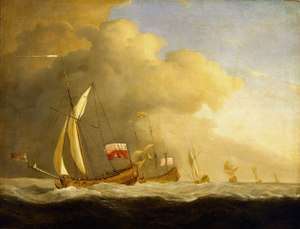HMS Gloucester (1654)
HMS Gloucester was a 50-gun, third rate, Speaker-class frigate, originally built for the navy of the Commonwealth of England during the 1650s and taken over by the Royal Navy after the restoration of the monarchy in 1660. The ship participated in multiple battles during the Anglo-Spanish War of 1654–60, and the Second and Third Anglo-Dutch Wars. Gloucester was wrecked in 1682 on a sandbar while carrying the Duke of York (the future James II).
 English Royal Yachts at Sea, in a Strong Wind in Company with a Ship (Gloucester) flying the royal standard, painting by Willem van de Velde the Younger | |
| History | |
|---|---|
| Name: | Gloucester |
| Namesake: | Gloucester |
| Ordered: | December 1652 |
| Builder: | Graves, Limehouse |
| Launched: | March 1654 |
| Commissioned: | 1654 |
| Fate: | Wrecked, 1682 |
| General characteristics | |
| Class and type: | Speaker-class frigate |
| Tons burthen: | 75511⁄94 (bm) |
| Length: | 117 ft (35.7 m) (keel) |
| Beam: | 34 ft 10 in (10.6 m) |
| Depth of hold: | 14 ft 6 in (4.4 m) |
| Sail plan: | Full-rigged ship |
| Armament: | 50 guns (as built); 60 guns (1677) |
Description
Gloucester had a length at the gundeck of 117 feet (35.7 m), a beam of 34 feet 10 inches (10.6 m), and a depth of hold of 13 feet 6 inches (4.1 m). The ship's tonnage was 755 11⁄94 tons burthen.[1] Originally built for 50 guns, in 1667 she actually carried 57 (19 demi-cannon, 4 culverins, and 34 demi-culverins). This was raised in 1677 to 60 guns. The ship had a crew of 210–340 officers and ratings.[2]
Construction and career
Gloucester was the first ship in the Navy to be named after the eponymous port.[3] Part of the 1652 Naval Programme, the ship was ordered on December 1652. She was built at Limehouse under the direction of Master Shipwright Matthew Graves, and was launched in March 1653 at a cost of £5,473.[2]
Battle Honours
Engagements in which HMS Gloucester took part include:[4]
- 1666: Four Days' Battle, Orfordness
- 1672: Solebay
- 1673: Schooneveld, Texel
The sinking of Gloucester

At around 05:30 on 6 May 1682, Gloucester struck a sandbank off Great Yarmouth, Norfolk. In a strong Easterly gale the ship was pounded against the sand until the rudder broke off and the ship was holed. The Duke of York and John Churchill (the future Duke of Marlborough) were rescued in the ship's boat. Boats from the accompanying fleet managed to save many of the crew, but around 120 sailors and passengers lost their lives. Victims of the sinking included Robert Ker, 3rd Earl of Roxburghe and Donough O'Brien, Lord Ibrackan and Sir John Hope of Hopetoun,Hope of Craighall .[5]
Notes
- Lavery, p. 159.
- Winfield, p. 408.
- Colledge, p. 143.
- "HMS Gloucester Royal Navy". 5 November 2014.
- Hyde Rochester, Laurence. The Correspondence of Henry Hyde, earl of Clarendon and of his brother Laurence Hyde, earl of Rochester. pp. NARRATIVE FROM SIR JOHN BERRY, KNIGHT, LATE COMMANDER OF HIS MAJESTY'S SHIP GLOUCESTER.
References
- Colledge, J. J.; Warlow, Ben (2006) [1969]. Ships of the Royal Navy: The Complete Record of all Fighting Ships of the Royal Navy (Rev. ed.). London: Chatham Publishing. ISBN 978-1-86176-281-8.
- Lavery, Brian (2003) The Ship of the Line - Volume 1: The Development of the Battlefleet 1650–1850. Conway Maritime Press. ISBN 0-85177-252-8.
- Winfield, Rif (2009) British Warships in the Age of Sail 1603–1714: Design, Construction, Careers and Fates. Barnsley, UK: Seaforth Publishing. ISBN 978-1-84832-040-6.
External links
